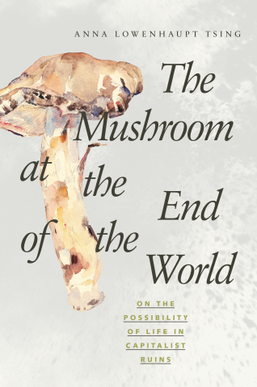The Mushroom at the End of the World
The Mushroom at the End of the World: On the Possibility of Life in Capitalist Ruins is a significant work by Anna Tsing, an anthropologist known for her interdisciplinary and innovative approaches to understanding human and non-human interactions within ecological systems. Published in 2015, Tsing's book explores the complex relationships between humans, non-human entities, and economic systems through the lens of the matsutake mushroom. This mushroom, highly valued in Japanese cuisine and culture, serves as a focal point for Tsing's exploration of life and survival in the ruins of capitalism.
Overview[edit | edit source]
The book delves into the world of the matsutake mushroom, found in the forests of the Pacific Northwest, among other locations around the globe. Tsing uses the matsutake as a metaphor to discuss the possibility of mutual survival in the damaged landscapes left by capitalist exploitation. The narrative weaves together ecology, economy, and social relations, presenting a multifaceted view of how diverse species, including humans, interact and depend on each other in a capitalist world.
Themes[edit | edit source]
Several key themes emerge in The Mushroom at the End of the World:
- Precarity and Survival: Tsing examines how beings thrive in the margins and ruins of capitalist destruction, highlighting the precarious nature of existence for both humans and non-humans.
- Interconnectedness: The book emphasizes the interconnectedness of life, showing how the survival of species, including humans, is deeply intertwined with others in complex ecological networks.
- Capitalism and its Discontents: Tsing critiques the global capitalist system, illustrating how it creates ruins and destruction, yet also pointing out the spaces and opportunities for life within these ruins.
- Cultural and Economic Value: The matsutake mushroom serves as a case study for understanding how cultural and economic values are constructed and how these values influence human and non-human interactions.
Reception[edit | edit source]
The Mushroom at the End of the World has been widely praised for its innovative approach to anthropology and ecology. Critics have lauded Tsing's ability to blend storytelling with academic analysis, creating a work that is accessible to a broad audience while providing deep insights into the complexities of life in the Anthropocene. The book has sparked discussions across various disciplines, including anthropology, ecology, economics, and environmental studies, highlighting its impact on contemporary thought regarding capitalism and ecological survival.
Impact[edit | edit source]
Tsing's work has contributed significantly to discussions about the Anthropocene, the current geological epoch characterized by human impact on Earth's geology and ecosystems. By focusing on the matsutake mushroom and its entanglements with human and non-human lives, Tsing offers a unique perspective on how to imagine and foster multispecies survival in a rapidly changing world. The book encourages readers to think beyond traditional narratives of ecological destruction and to consider the possibilities of living and thriving in the ruins of capitalism.
See Also[edit | edit source]
Search WikiMD
Ad.Tired of being Overweight? Try W8MD's physician weight loss program.
Semaglutide (Ozempic / Wegovy and Tirzepatide (Mounjaro / Zepbound) available.
Advertise on WikiMD
|
WikiMD's Wellness Encyclopedia |
| Let Food Be Thy Medicine Medicine Thy Food - Hippocrates |
Translate this page: - East Asian
中文,
日本,
한국어,
South Asian
हिन्दी,
தமிழ்,
తెలుగు,
Urdu,
ಕನ್ನಡ,
Southeast Asian
Indonesian,
Vietnamese,
Thai,
မြန်မာဘာသာ,
বাংলা
European
español,
Deutsch,
français,
Greek,
português do Brasil,
polski,
română,
русский,
Nederlands,
norsk,
svenska,
suomi,
Italian
Middle Eastern & African
عربى,
Turkish,
Persian,
Hebrew,
Afrikaans,
isiZulu,
Kiswahili,
Other
Bulgarian,
Hungarian,
Czech,
Swedish,
മലയാളം,
मराठी,
ਪੰਜਾਬੀ,
ગુજરાતી,
Portuguese,
Ukrainian
Medical Disclaimer: WikiMD is not a substitute for professional medical advice. The information on WikiMD is provided as an information resource only, may be incorrect, outdated or misleading, and is not to be used or relied on for any diagnostic or treatment purposes. Please consult your health care provider before making any healthcare decisions or for guidance about a specific medical condition. WikiMD expressly disclaims responsibility, and shall have no liability, for any damages, loss, injury, or liability whatsoever suffered as a result of your reliance on the information contained in this site. By visiting this site you agree to the foregoing terms and conditions, which may from time to time be changed or supplemented by WikiMD. If you do not agree to the foregoing terms and conditions, you should not enter or use this site. See full disclaimer.
Credits:Most images are courtesy of Wikimedia commons, and templates Wikipedia, licensed under CC BY SA or similar.
Contributors: Prab R. Tumpati, MD

